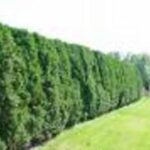If you’re looking for a low maintenance, easy-care evergreen to grow indoors, look no further than the Norfolk pine (Araucaria heterophylla), also known as Norfolk Island. I love this tree, which by the way responds exceptionally well to an indoor potted environment. Just provide it with suitable conditions and the Norfolk pine will thrive, providing year-round interest as a focal point in the home. You can even use it as a makeshift Christmas tree over the holidays-one that never requires throwing out and can be used again year after year.
So what type of growing conditions does the Norfolk pine need? First off, give the tree well-draining potting soil, or a 3:1 peat mix, in an adequately sized container, preferably one size larger that the pot it came in. Keep the soil moist but not soggy, as Norfolk pines resent overly wet conditions. In fact, too much water will result in sporadic clusters of bright yellow needles as well as the shredding of green ones. Therefore, only water the tree when the soil feels slightly dry. Although not required, you can give your Norfolk pine a water soluble fertilizer (diluted to about ½ strength) during summer.
Norfolk pine enjoys bright, indirect light. Insufficient light may result in droopy looking plants, needle dropping, and poor growth. If possible, place your tree near a suitable window, within 3-4 feet to prevent needle burn, and turn the tree periodically. Also, try to keep you Norfolk pine in a cooler area of the home. This evergreen performs best when grown in daytime temps that hover around 65 degrees F. and somewhat cooler nighttime temperatures. Humidity is another important factor when growing Norfolk pines indoors. Low humidity leads to tip browning, needle drop, and may even cause the lower branches to die. Regular misting or the use of a humidifier can usually alleviate humidity issues.
The only other care that your indoor Norfolk pine require is the very occasional repotting and pruning. Since the tree doesn’t particularly like having its roots disturbed, repotting is only necessary every 3-4 years. This helps maintain its vigor and freshens the soil (unless you have a cat that enjoys urinating in it, which doesn’t do much for the soil at all and can quickly threaten the livelihood of your tree-Unfortunately, I learned this firsthand.). Repotting is usually best achieved in the spring. As for pruning, this is normally done only to remove any brown tips or dead branches. New growth of Norfolk pines only occurs at the topmost portion of the tree. Any pruning that is performed will result in the termination of its growth.
So that’s it. Provide your potted Norfolk pine with the right conditions and you can enjoy this easy-care tree indoors year after year.
Resource: personal experience



